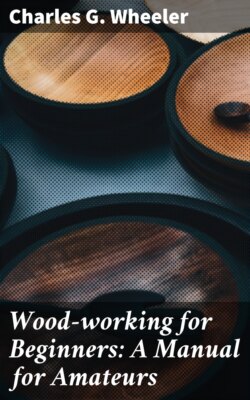Читать книгу Wood-working for Beginners: A Manual for Amateurs - Charles G. Wheeler - Страница 11
На сайте Литреса книга снята с продажи.
ОглавлениеFig. 35.
For instance, if you were to put cleats on one side of a drawing-board three feet wide, and were to firmly glue the cleats for their whole length (Fig. 35)—you sometimes see such things done—you would probably not have to wait many weeks before you would hear a report like a toy pistol, and the cleats would be loosened for at least part of their length, because of the expansion or contraction of the board. Similar cases are continually occurring. In such cases the cleats should be screwed, the screws having play enough in their holes to allow for the changes in the board (see Appendix).
You must also make plenty of allowance for planing down edges and surfaces and for the wood wasted by sawing. No rule can be set for these allowances. If you do not leave enough spare wood, the pieces will finally come out too small. If you leave too much you will increase the amount of planing or shaping to be done, but of the two extremes it is better to err on the side of allowing too much.
A rod (any straight stick), say six feet long, and another ten or twelve feet long, with feet and inches marked, are very handy to have when laying out work roughly, or for measuring outdoor work approximately.
Lay out your work from only one edge or one surface of a piece of lumber unless you are sure the edges or surfaces are exactly parallel. Having selected the best edge for a "working edge" and the best surface for the "face," mark them with an X or other mark to avoid mistakes (Fig. 36). This is quite important in laying out a number of pieces, as before the stock is accurately worked into shape you cannot usually rely on the edges being parallel. One mark like a V as shown in Fig. 36 will indicate both the working edge and the face.
Fig. 36.
Estimating.—You must, of course, learn to make your estimates yourself, often a very important preliminary. Prices vary, and you cannot always rely on other people's estimates for your own work. It is a matter of simple arithmetic and of making correct allowance for waste and incidentals.
You can always get the prices easily. Figure the amount of wood required, the number of square feet (see page 47) of each kind, or running feet, as the case may be, and multiply by the price a foot; but after this comes the allowance for waste, etc., which cannot usually be figured exactly, but must be estimated.
For instance, if you wish to make a double-runner, with a seat ten feet long, the board from which to make it will very likely be twelve feet long, in which case you must, of course, buy the whole board. Perhaps you can use the two feet left over somewhere else on the sled, perhaps part may be checked or injured.
There is almost always some defective wood (worthless, except for fuel); some pieces are too short or small to be of use; and very often some quite good-sized pieces are left over, which, so far as the particular job is concerned, are waste—that is, you must buy them in order to get enough. Such pieces can be used on other work, and are not really wasted in the end.
Just how much to add to the number of feet to cover waste varies, of course, with every job. Some people add a fixed per cent. to their measurements or calculations, which, although not exactly correct for any one job, strikes an average for a good many. It would not be easy to state any such per cent. for the varied work you will do, but the main thing to bear in mind is that you must make a liberal allowance. Just so with the other materials. Remember to allow for waste and for unforeseen extras. Even with experienced people things are very apt to cost more than the estimate.
Make a neat schedule to take to the lumber-yard or mill, specifying the kinds and dimensions of the stock required.
